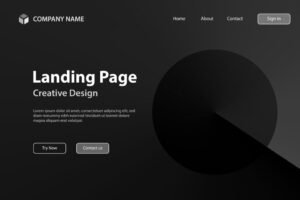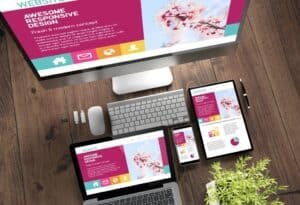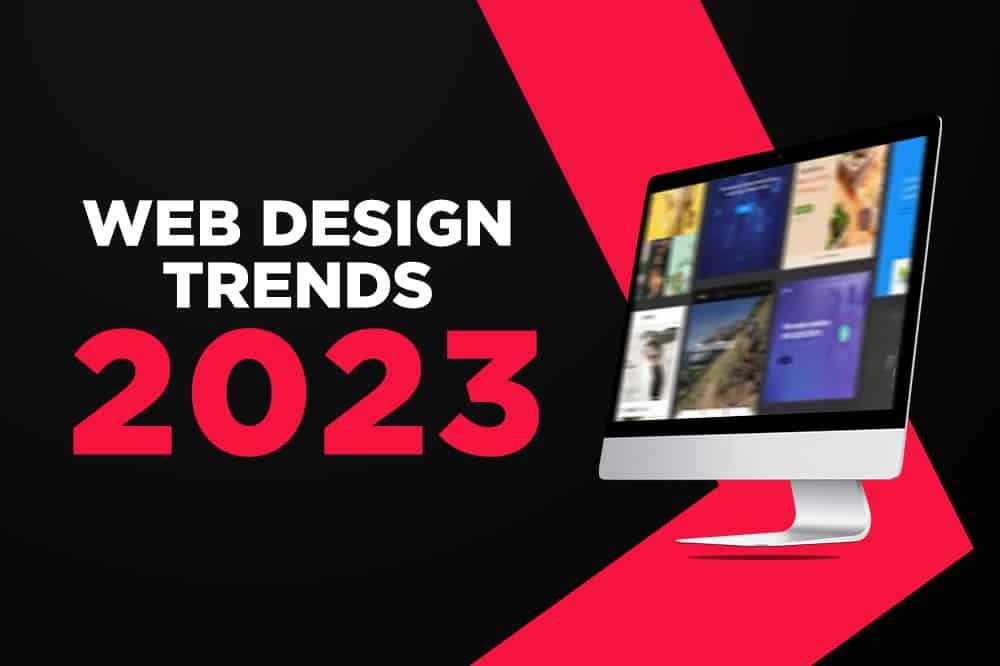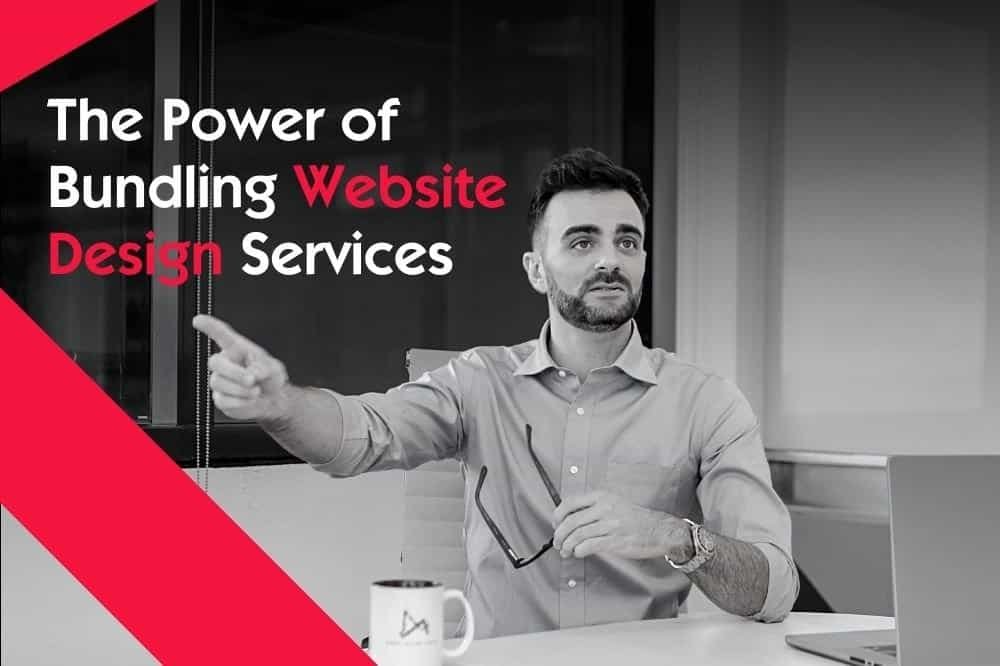With time, new marketing trends and super talented visionaries, web design has evolved into something unlike it’s ever been. Whether you’re a designer, developer or business owner, it’s so critical to stay on top of the latest trends to ensure your website is looking fresh and modern.
As we kick off 2023, there are a number of key web design trends that are poised to take the world of websites by storm over the next several months.

How Has Web Design Changed In The Past Year?
UX trends have changed significantly over the last year due to a number of advancements in technology. One of the biggest factors is the continued growth of mobile and tablet usage. As more and more people access the internet on mobile devices, designers have had to adapt their work to ensure that the website can be optimized for a variety of screen sizes and resolutions.
Another factor that has contributed to the change in web design trends is the emphasis of an artistic, functional approach to the user experience (UX) design. With the focus shifting away from just making a webpage look good, designers are now focusing on creating an intuitive and enjoyable user experience for visitors. This has led to a greater emphasis on simplicity and minimalism in web design.
Websites aren’t just parallax scrolling portfolios anymore. We’re seeing so many digital consultants, coaches, and thought leaders demanding sites that do multiple things like selling courses and webinars, downloadable ebooks and white papers, and telling a compelling story…all while matching their personal brand.
The Role of AI
New technologies have taken over and play a role in the change of web design trends. For example, the popularity of artificial intelligence (AI) has led to a rise in voice search and chatbots, which have required designers to rethink how they structure and present information on their websites.
Additionally, the shift towards digital marketing has also played a role in changing web design trends. In order to effectively attract and convert online traffic, designers have been experimenting with new elements such as data visualization, custom illustrations and micro animations, and interactive elements to make their sites more engaging.
Overall, so many things happened to force significant changes in UX best practices over the last year, but the common theme is the continued focus on creating an optimal user experience and making a website stand out in an overpopulated digital landscape.

Now, Those Top 10 Website Design Trends To Look Out For
There are tons of new things happening in 2023, especially with more and more tools and graphic elements becoming available this year. Here is our list of the ten hottest items to be aware of.
Dark Mode
Also known as “night mode,” this is a trend that has been gaining popularity in web design over the past few years and it is expected to be even more popular in 2023. Dark mode is a cool feature that allows users to switch the background of a website or application from a light color to a dark color, making it easier on the eyes in low light conditions.
One of the main reasons for the popularity of dark mode is that it helps to reduce eye strain and fatigue when using a device for long periods of time. This is especially true for users who spend a lot of time looking at screens in dimly lit environments.
It doesn’t just help with eye strain, dark mode can also help to conserve battery life on mobile devices, as darker colors use less power than lighter colors.
Another reason for the popularity of dark mode is that it’s just downright cool and sleek. This can help to make a website really “pop” when stacked up against competitors sites.
Dark mode is also becoming a popular trend as it aligns with the growing trend of minimalism in web design. Dark mode allows designers to create clean and uncluttered layouts, focusing the user’s attention on the most important elements of the page.
A darker colored option is also more comfortable and easier to navigate on small screens and cell phones, as it reduces glare and makes text more legible.

White Space
Also known as negative space, this is a faux pas trend that is gaining popularity in web design as we head into 2023. White space refers to the areas of a page layout that are left empty or unoccupied, and it serves an important role in creating a clean, uncluttered overall look on the site.
One of the main reasons for the popularity of white space is that it allows designers to create a sense of visual hierarchy in their layout. By utilizing these spaces, the user’s attention is drawn to the most important elements of the page, such as headlines, calls to action and key information. This is particularly useful in creating a clear and easy to navigate website.
By using plenty of white space, a sense of calm and order is envoked on a website while giving it a sense of balance and proportion, which can help to create a more pleasant and enjoyable user experience.
Empty space can actually be utilized artistically, which also aligns with the minimalist trend taking the world by storm. By using a minimal design approach, designers can create a more modern and sophisticated aesthetic.
Organic Shapes
Gone are the days of rigid, geometric shapes in web design. Instead, designers are embracing organic shapes and using them to create a more natural, flowing feel to their layouts. This refers to shapes that are not strictly geometric, but rather have a more natural, flowing feel to them. They can include shapes such as circles, waves, and irregular polygons.
Natural looking shapes invoke a more relaxing vibe on a website. Organic shapes can be used to create a sense of movement and flow, which can help stimulate the user’s mind and put them in a more energized state, which helps with conversions.
Organic shapes can also be used to create a more unique and personalized look for a website. When designed properly, these custom illustrations and graphics help to convey a brand’s message in a creative and memorable way.

Smart Video
Video is a powerful tool in web design, and this year we’re seeing a trend towards “smart video” that can adapt to the user’s device and connection speed to ensure a smooth viewing experience.
The reason smart video is widely used now is that it allows designers to create a more engaging and personalized experience on the site. By using video, designers can create a more immersive and interactive interface for users, which can help to keep them engaged and on the website for longer.
Smart video actually allows designers to better cater to the needs of mobile users because they can automatically adjust the video quality based on the user’s connection speed and device capabilities. This means that users will be able to watch videos on mobile devices without having to deal with buffering or other loading issues.
As video becomes an increasingly popular way to attract and convert website visitors, designers have been experimenting with new ways to present video in the web development process. So look out for some super intuitive video players this year.
Material Design
Material design is a design language developed by Google that is becoming a major part of web design. It was introduced in 2014 and provides guidelines for creating a visually pleasing and intuitive interface.
Material design is characterized by its use of bold typography, serif fonts, clean layouts, and the use of angles and shadows to create a sense of depth. This language is based on the idea of creating a unified visual language that combines the classic principles of good design with the innovation and technology of today’s digital age.
Custom Illustrations
Custom illustrations are another trend that is gaining popularity in web design. They can help to create a unique, personalized feel for a website and can be used to convey a brand’s message in a creative, memorable way.
Kinetic typography is a theme we’re seeing a lot lately. This is basically fonts that move on the screen, whether it be scrolling across or down the viewport, or reshaping when the user hovers their mouse. It’s useful for brands that focus on font combinations and need more sophisticated typographic layouts.

UX Design
As the focus on user experience (UX) continues to grow in importance, there are a number of new best practices that designers should keep in mind when creating websites in 2023.
- Mobile-First Design: With the continued growth of mobile navigation, it’s more important than ever to develop sites with a mobile-first approach. This means designing for the smallest screen first and then working your way up to larger screens.
- Simplicity and Minimalism: Simplicity and minimalism are key to creating a great user experience and making the website load fast. By using clean layouts and limiting the number of elements on a page, designers can make it easier for users to find what they’re looking for and make their way around the site.
- Personalization: Personalization is becoming an increasingly important aspect of UX design. By using data and user behavior to create a personalized experience, designers can help to create a more engaging and enjoyable environment.
- Micro-interactions: Small animations and interactions can make the page more entertaining. They can also be used to provide feedback, guide users through a process, or simply add a touch of personality to a website.
- Chatbots and AI: As the use of artificial intelligence (AI) and chatbots continues to take over, designers are incorporating these concepts to provide a more efficient and personalized experience for users. They can help users with their frequently asked questions and even make personalized recommendations.
- Accessibility: Designing for accessibility is becoming more important than ever. By making a website accessible to users with disabilities, designers can ensure that everyone can access and use the site, while staying compliant.
- Clear Navigation: Clean navigation is crucial for visitor engagement. Designers should make sure that the navigation is easy to find and use, and that it makes sense for the type of website they are creating.
- Social Media: For a few years now, we’re seeing that social media has also had a big impact on web design trends. With the rise of Instagram and Pinterest, designers have been experimenting with new ways to present visual content as a live feed on the site itself.

Responsive Design
Responsive design is a must for any website in 2023. Everyone is accessing the internet on mobile devices, so it’s essential that each webpage is optimized for a variety of screen sizes and resolutions.
A responsive site will look and work well on a wide range of devices. If not, it may not display correctly on smaller screens, and users may have difficulty navigating and using the website.
Responsiveness also helps to improve search engine optimization (SEO) performance and ranking. Search engines tend to favor sites that are mobile-friendly and provide a good user experience. Therefore, a website that is designed to respond to different devices and screen sizes is more likely to rank higher in search engine results.
If you, or someone you know has a site that doesn’t conform to all screen sizes, then it’s definitely time for a new website redesign.
Data Visualization
Data visualization is becoming a key trend in web design. By presenting data in a visually appealing way, designers are able to help users understand complex information more easily.
Frosted Glass
Frosted glass is a design element that is also gaining traction in UX. It is a technique that creates a translucent or frosted appearance on elements on the page, such as images or text. The effect can be achieved by using a semi-transparent overlay or by applying a blur filter to an element.
Take The Next Step
If you’re building digital properties for clients, your own business or just learning new tricks, it’s might be a good idea to practice and perfect a few of the trends that we think will take the world of website design by storm in 2023.
By keeping an eye on these trends and incorporating them into your own procedures, you can ensure that your websites stay fresh, modern, and user-friendly.















